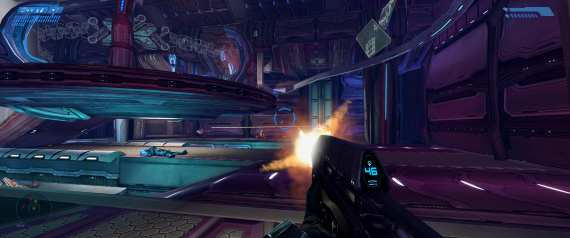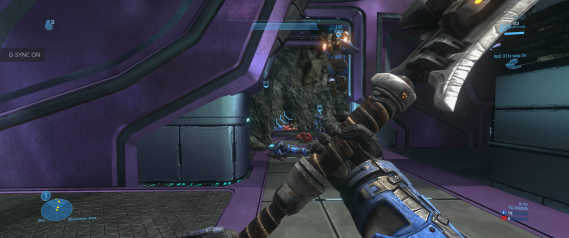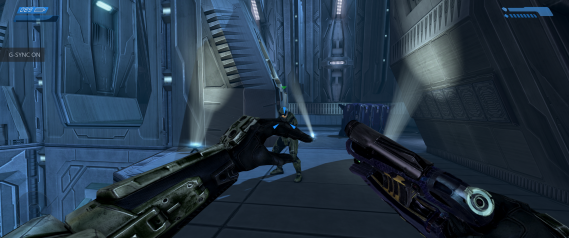They did it. The world is going crazy, but the mad lads at 343 Industries got another Halo campaign out on the PC in 2020. We are one step closer to achieving the Year of Halo.
The original Halo: Combat Evolved is – surprise surprise – hugely nostalgic for me. I had a friend who got the game Day 1 alongside four controllers at the 2002 launch of the original Xbox. I wouldn’t have admitted it at the time, but I was definitely jealous. As a Nintendo kid by trade I was already well used to console launches boosted by games in well-known franchises, so the Xbox came in with a definite disadvantage; but Bungie’s Halo was just so ridiculously polished that playing it made you quickly forget its status as a series debut. Halo didn’t originate twin-stick FPS controls, but it refined them and brought them into the mainstream; the jank of Goldeneye and Perfect Dark would never be convincingly disguised again. The splitscreen multiplayer experience on Blood Gulch is now legendary. I don’t think it’s that controversial to call Halo: Combat Evolved one of history’s greatest console launch titles.
But despite three or four attempts over the decades, I have never surpassed the second level of the first Halo campaign. The notoriously minimap-free level design has tripped me up on more than one half-hearted occasion over the years. That finally changed early last month, when I lined up a Halo-loving mate for another tilt at the campaign that started it all – now with yet another new coat of paint and a handy suite of fresh features on the mighty PC. Thanks to all manner of spicy technical difficulties, it would eventually take us almost two months to get it finished. But before we began, it was time to play some Halo multiplayer again at last.
With the addition of Halo: Combat Evolved Anniversary to the ambitious Master Chief Steam/Windows Store project came a raft of new and returning players, so I dusted off my extremely rusty skills and jumped into a Reach/Combat Evolved mixed playlist with the same friend. One of my great shames is that mouse and keyboard FPS controls give me mild motion sickness these days, so I used my elite controller – but to my surprise I did about as well as I did on Xbox back in the day, if not slightly better. Long-buried level layout information came bubbling up and my aiming reticle began to rest naturally at head level. I suppose I can thank that sweet, sweet Halo gameplay loop, which was tailor-made to sit nicely on a gamepad all those years ago.
And how sweet that very loop is. Though their initial releases were separated by nearly a decade, switching between the first Halo and Reach from match to match is only feasible at all because this series is powered by a surgical combat system that has stood the test of time. If most other shooters resemble Hungry Hungry Hippos, Halo is a round of Connect Four. Each combat encounter is a dance marked by several crucial moves that decide its outcome. Fully automatic weapons are generally ineffective compared to the legendary Halo suite of Magnum, battle rifle, DMR and sniper rifle; but none of these will get rid of an enemy shield as quickly as a well-timed energy bolt from the most common weapon in the game, the Covenant plasma pistol. Halo is the closest a shooter has ever come to the thrills of high-end competitive Pokemon; once you know how much damage a shot or melee strike will do, it’s a simple – yet far from easy – matter of juggling your limited arsenal for the best combination of “super-effective” hits for that situation. If your teammates have already put your opponent into KO range with their glancing blows, fewer evasive manoeuvres are necessary and you can be more aggressive with your approach. Maybe that’s why I gravitate towards the feel of Halo over other multiplayer shooters even now.
Anyway, enough strained metaphors and adjusting of monocles. Time to talk about how this surgical combat system got its start – that iconic original Combat Evolved campaign.
Much like Reach enjoyed as part of the PC Master Chief Collection, the OG Halo supports ultrawide resolutions and adds some graphical flourishes on top of the existing graphical presentation. In this case, however, the port in question is based off an existing remake: 2011’s Combat Evolved Anniversary. So that release’s most mind-blowing feature – the ability to switch between the original Halo visuals and the remade assets – survives the transition with some rather bizarre results. Not only can you now play the first Halo game in an aspect ratio almost twice its original width, but in a few interior locations the newer lighting effects layered on the old textures give proceedings a uniquely grim and foreign atmosphere. These moments arguably work better than they do with the new graphics to establish the foreboding mood surrounding an unknown alien installation.
But these are few and far between. Most of the time the newer sheen absolutely knocks it out of the park. The high-contrast colour palette of Combat Evolved makes the subtlety and growing dread of Reach appear grey and lifeless – which it certainly isn’t. Vibrant hues surge across the screen and light up the outdoor backdrops as the Master Chief makes his official chronological debut exploring the eponymous Halo ring. The in-universe explanation for this is covered by said ring’s enigmatic otherworldliness, but make no mistake – this is a game about hope. Especially after playing Reach, Combat Evolved looks and feels like optimism given life – even despite those dark interior corridor moments, the frequent night time scenes, and the fact that the war against the Covenant is really just getting started. It’s a neon dream backed up by an influential orchestral soundtrack with more than a few crunchy 1980s flourishes.
That said, it often feels a bit like blind optimism. That aforementioned lack of minimap was a progress killer back in the day and without my patient friend along for the ride this time, it may have struck again. Sprawling outdoor maps packed with exciting enemy encounters would become a real strength of the Halo series over time, but in the first entry it’s clear there were strides still to be made. Straight after it has opened with one of the most trailblazing first levels in gaming history, The Pillar of Autumn – an early-millennium example of tutorial and storytelling rolled into an accelerating ball of concussive gameplay – Combat Evolved has our Chief crash land on the Halo ring with an expansive mass of pretty rocks and grass. He must locate the escape pods containing his comrades, but with next to no indication of where the first one is, the player is expected to wander around until the shooting starts again. In 2001 this would have felt overwhelming in a mightily impressive way, but even with the updated ambience, it only feels dated nowadays.
Two heads are much, much better than one here – especially if one of them has a history of actually beating the level – but both of us were scratching our heads trying to navigate a samey cyan underground maze a few levels later. Then, a few hours after that, a slightly different shade of blue began to haunt us as we struggled to make our way through a labyrinth of elevators, pits and rooms with identical layouts. We didn’t even see a waypoint until our final couple of hours. The game never quite shakes its habit of attempting to confound the player, for better or worse. Given the heights the series would later hit, mostly for worse.
Regardless, thanks to my co-op partner’s veteran status I finally got to experience the glory of The Silent Cartographer – The fourth stop on the H:CE campaign journey and one of the entire series’ most praised levels. After almost two decades of hearing about how good it was, I was ready to pick holes in it but came away pretty impressed. Another large outdoor affair, Cartographer avoids the perils of the earlier hours by keeping a picturesque beach to the player’s right and a giant unyielding cliff to the left. It gives you a Warthog all-terrain vehicle early on and encourages you to make good use of it, then peppers the path with optional side fights and even more exciting vehicles. There’s always something to chase down or escape. A grand old time indeed.
Naturally, such is the legacy of Halo’s debut that there is yet another iconic moment lying just a few steps further into the story; a moment I called out on this blog years ago on the strength of its reputation alone, yet one that still got under my skin and made it crawl when I experienced it on my PC monitor. I am, of course, referring to the discovery of the Flood.
Using a technique that would later reappear throughout Halo 3: ODST (The only Halo campaign I’d finished before this year), the Master Chief picks up a cold helmet in the middle of a pool of blood and views the recorded final moments of its former owner. Cue a stylised mint-shaded flashback heavily inspired by the early helicopter scene from Predator and laced with all manner of horror movie tropes – The tiny parasitic Flood creatures swarm the screen in alarming numbers as the screen shakes with panic and the cries of confused marines dot the audio landscape. Control returns to the player, you open a door on the far side of the room and suddenly you’re experiencing the same thing, but in full grotesque colour. I don’t know if there were more of the little bastards added to this scene in the remake or whether they were always this populous, but I was yelling down the microphone in horror and disgust regardless. It’s a great moment and it truly holds up.
Following a decade-long history of playing Halo primarily as a competitive multiplayer and co-operative firefight outlet – with the odd campaign mission thrown in – it was surreal to realise that I had never actually fought the Flood before. Gameplay-wise their primal nature means they lack energy shields, and therefore don’t take too well to human bullets. Combine that with their sheer force of numbers and the humble default assault rifle suddenly becomes a shockingly effective weapon. Seeing a 00 on that famous triangular ammo display was virtually a new experience for me, and not a pleasant one. Luckily I didn’t have to get used to it, because shortly after the Flood are introduced comes still another famous level – The Library. Boy oh boy, does this set piece give you ammo.
I haven’t experienced too many zen first-person shooter moments like The Library’s half-hour torrent of grim bloated monstrosities. Straightforward and confident in its own second-by-second gameplay loop like just about nothing else I’ve ever played, the action is sustained by the rather genius mechanic of rewarding each major scalp with a dropped weapon from its host. Because plenty of said hosts were once human, you actually get some decent weapons; ammunition top-ups for your assault rifle are accompanied with shotgun shells, and if there was ever an environment designed for the shotgun to shine it’s this one.
Getting up in the face of something that could off you with one self-destructive explosion and backing up into oodles of space, reloading and switching to the AR to pick off the swarming by-products starts to feel positively rhythmic after a while. The odd sucker punch from behind you can happen, which my mate told me can get real frustrating on solo playthroughs, but if you have a partner to back off and secure your respawn when needed, the strange party kicks on. It’s no wonder the eventual advent of the Firefight mode in Halo 3: ODST felt so good to play when the series was already so adept at nailing that so-called ‘horde mode loop’.
The rest of the campaign pulls the odd but totally understandable move of reusing several older environments more or less in reverse, re-contextualising them with multiple enemy types and a steadily more urgent narrative path. After the Chief finds out that the Halo ring is essentially a terrifyingly capable Death Star facsimile, his escape becomes much more difficult than his approach. The Covenant and Flood enemies continue to arrive in huge numbers but the corridors get narrower and narrower. By the time we returned to the crashed Pillar of Autumn during the last level, every tight turn held the promise of either a face full of shotgun blast, a shattering blue explosion, or both. My friend and I had to stay far apart to ensure one of us catching a stray plasma grenade didn’t send us both back a checkpoint. Reaching the end of each tunnel felt real good.
If the synthesised audio flourishes and early Predator vibes weren’t evidence enough of old-school Bungie’s nostalgia for the 1980s, the final stretch’s multiple lashings of Star Wars (particularly Return of the Jedi) flavour really seal the deal. At one point you literally have to toss grenades into half-open exhaust ports while dealing with unlimited enemy respawns, and when that’s done you jump into a Warthog and high-tail it down a narrow path trying not to trip up on obstacles or particularly nasty enemies. Chief then runs up a closing ship ramp while enemies fire energy bolts at him, making it just in the nick of time. Cue a very familiar cut to space, and a spectacular (for the era) explosion. The early 2000s were a different time, well before such obvious inspiration might have been shouted down on Twitter, but man, the narrative drama of it all still works.
It wasn’t until the final note of that wondrous melody faded out against a starry sky that I realised it: There really isn’t a lot of characterisation in the first Halo outing. Part of me was expecting a bit more substance from the characters that would become fan-favourites over the years – the likes of Sergeant Johnson, Commander Keyes and especially Cortana. After all, few gaming properties can boast as much expanded lore as Halo can. Of course it didn’t take much longer than a few moments to realise that such expectations were lofty at best. This project was pretty far from a guaranteed success before it launched, and crafting a story with momentum to match the gameplay was clearly a major focus for the developers. Though he doesn’t say much, this is a story about Master Chief striking a decisive blow against the imposing force that crushed Reach, and it serves that purpose well. The aforementioned three characters do a whole lot of their most heroic stuff offscreen, which laid out just enough crumbs to provide a feast for fans – not to mention a whole lot for canon writers to chew on later.
I can’t make too many more conclusions until I’ve played through the next chapter of the saga, which incidentally is the only Halo game I’ve never played. But I am so grateful I finally got to experience some of FPS history’s most iconic campaign moments in Combat Evolved co-op. Even if some nights we were troubleshooting as much as playing; even if a little too much time was spent scurrying in circles through mazes without waypoints or mini-maps; it wasn’t simply two decades of pent-up curiosity pulling me through this gauntlet. There are moments of finely-tuned videogame magic at play within the Halo: Combat Evolved story that remind me why I can never leave this series alone for too long. Now the OG is at last in my rear-view mirror, we look ahead. As things look at the time of writing, arguably the most popular title in the series may be making its triumphant PC return rather soon.
As the Master Chief says at the end of his first adventure, we’re just getting started.
.
NEXT > Halo 2
Halo Reach < PREVIOUS
























